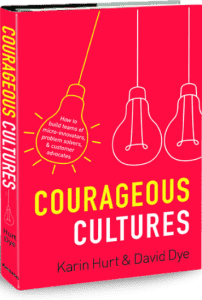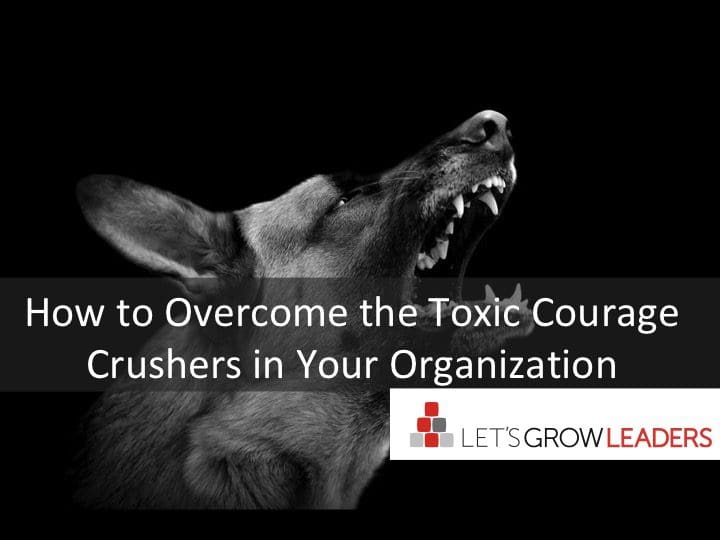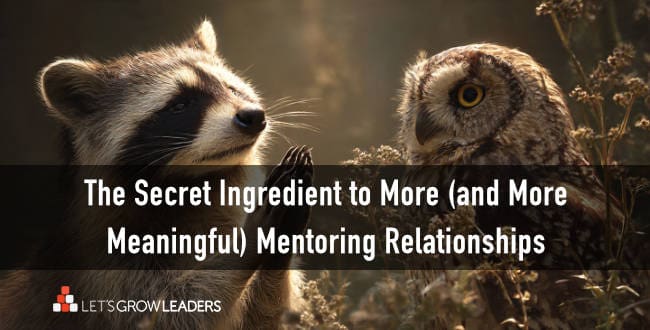Eliminate the Toxic Courage Crushers
The irony of a courageous culture is that it takes less daily courage to be successful. If you want to build teams of micro-innovators, problem solvers, and customer advocates, eliminate the toxic courage crushers intimidating your people.
Eliminate the Courage Crushers
A doctor was trying to do an experimental procedure I knew could hurt a child
(and was also against the parent’s consent), so I blocked the door.
—Pediatric Nurse
Jane, a committed nurse in one of our high-potential programs, shared the exhausting list of daily stupidity she faced from a bullying, narcissistic doctor—just to get her job done. She felt like every day was a courageous battle to advocate for her patients’ needs. Her requests were met with sarcasm and micro-retaliation.
She said that the administration knew of his antics but looked the other way because he was renowned in his field. The other participants in the session corroborated her story with frustrated nods. “That’s why we have Fear of Speaking Up (FOSU)—you can’t change a guy like him. And he’s just one of many courage crushers around here.”
“Why do you stay?” Karin asked.
Jane’s eyes welled up (as did Karin’s and pretty much everyone else’s in the room). “I just care so deeply about the patients. They’re just very sick kids who need someone paying attention who cares.”
Jane eventually left for another role where her passion and commitment were appreciated. That department lost a remarkable nurse. You can’t possibly build a Courageous Culture if you tolerate even one guy like that—word spreads fast. Your Janes will go elsewhere.
And Jane’s not alone. When people hear of our research, many share their stories of difficult situations where they had to overcome a toxic situation.
A few quotes from our research.
- “My boss was exaggerating the numbers to our leadership team. I held fast to the truth.”
- “I stood up to a boss who was trying to bully me.”
- “I called ethics because I was tired of all the screaming. And then I got retaliated against for calling ethics.”
- “They asked me to tell the truth about the CEO’s behavior. I did and he was fired.”
- “My integrity clashed with the executive team’s direction, so I quit.”
Zero Tolerance: Stop the Courage Crushers
Sobering answers, aren’t they? When people spend their courage reserves just getting past the bad stuff, there’s no energy left for the courage your business needs most—creative problem solving and micro-innovation.
For most people, innovation takes energy and courage—the courage to be vulnerable, to risk rejection from their peers, or to invite uncertainty.
Your people can make that effort only a limited number of times before they’re done. The more courage they use to address injustice, toxic leadership, needless politics, or poor decision-making, the less energy they’ll have to spend on what really matters. You won’t get any of the courage you need to serve your customers or build your business if it takes a heroic effort just to fight against an existing caustic culture. To build a culture that leverages and amplifies every act of courage from every team member, start with a foundation of safety and clarity.
If you’re serious about building a Courageous Culture, you can’t tolerate even an ounce of harassment or bullying—from anyone, but especially from anyone in a management or leadership role (even if they are otherwise rockstar performers). If it takes a week’s supply of courage for an employee just to show up for another day, you’re wasting money and talent.
 Beyond “Me Too” and Other Injustice
Beyond “Me Too” and Other Injustice
It’s interesting: when we are interviewed about our Courageous Cultures research, one of the first topics reporters ask about is sexual harassment and bullying. “Oh, FOSU, you mean like in the ‘Me Too’ movement? Yeah, let’s talk about that!”
Actually no. If you’ve got a culture rampant with sexual harassment and bullying, you’re not ready for any of the techniques in this book. You can’t possibly encourage innovation and problem solving when you haven’t solved the most fundamental problems: when people don’t feel safe and don’t know unequivocally that you value them at the most basic human level.
Before you start any of this, carefully examine your systems and infrastructure for injustice or unintended consequences that prevent people from focusing on the work that matters most.
Spend time with your frontline employees and really listen to what they experience every day. Ask courageous questions that give them an opportunity to tell you what really happens. Take the comments in your employee surveys seriously. For every employee that spoke up, there’s likely another who blew it off or stayed silent.
The Behavior of EVERY Leader Matters
When you’re looking to build a Courageous Culture, the behavior of every leader matters. We talk to so many senior leaders who convince themselves that they must tolerate the bullying or demeaning and intimidating behavior of an executive or middle manager because of “all the other things they bring to the table” (such as innovation, deep customer relationships, the biggest sales funnel). And then they tell us “they’re too valuable to fire.”
If this sounds familiar, think about the messages leaving a toxic leader in place is sending to your team. First, you’ve told your team that you lack courage. You’re not a strong enough leader to create a Courageous Culture. Next, you’ve told your team members that you don’t value them. If you did value them, you would ensure they were treated humanely. Finally, you’ve told everyone that this kind of abuse, harassment, and bullying is okay.
You’ve planted seeds for even more chaos and disruption. We’ve had countless managers raise their hands in our training sessions and say, “Well this all sounds great, but they’re not serious about that here. Otherwise [insert courage crusher leader’s name here] would not be so successful. It’s sad but that’s what it takes to get ahead around here.”
There is much research that shows that people tend to remember a bad emotional experience more than a good one. Even one courage crusher will be enough for many employees to see that this is the way “people like us”—or the people we aspire to be like—are encouraged to act. And they will see this even if they’re surrounded by a dozen other leaders proactively working to build the culture they want.
The Big Three Toxic Behaviors
The three most toxic behaviors we hear being tolerated (and even rewarded) are shaming, blaming, and intimidation. It’s the chief operating officer who projects a list of all her senior leaders in stack-ranked order on the screen at the company off-site meeting and then works her way through the list from the bottom up, sarcastically criticizing them in front of their peers and handing them a microphone to respond, while all their peers laugh nervously while silently praying they’ll be spared next time.
Or the vice president who berates his direct reports for a strategic choice “they made” that didn’t pan out, even though the VP was the one who made the final call despite the team’s concerns and objections. Or the executive who flies around on the corporate jet and delivers fix-it-or-else ultimatums, overlooks all the great results and leaves a wake of intimidation-induced frenzy—all to show how serious she is to make things better.
Shame, blame, and intimidation have no place in a Courageous Culture—and yet you might be surprised how frequently we encounter these counter-productive activities, even in organizations that invest in resources and systems to foster courage and innovation. Don’t let one or two bullies undermine your Courageous Culture strategy.
Courage Enabling Questions to Consider
If you are interested in building a courageous culture, we encourage you and your team to discuss these questions:
- Why Build a Courageous Culture?
- Why do you want a Courageous Culture?
- What specific outcomes are you looking to achieve?
- How will you know you are successful?
- What scares you? Why?
- What hard choices must you be prepared to make?
- Who’s with you? Who’s not? What support do you have? Why?
Avoiding Courage Crushers
- What processes do you have in place to prevent (and make it easy to report) bullying and harassment?
- What do you do when a high performer is a courage crusher who regularly abuses or harasses other people?
- Which of these courage crushers is the biggest source of vulnerability for your organization?
- What courage-crushing behaviors will you have a zero-tolerance for in your organization?
- Do your managers have the fundamental management and communication skills they need to implement a Courageous Culture?
 This article is an excerpt of our new book Courageous Cultures: How to Build Teams of Micro-Innovators, Problem Solvers, and Customer Advocates.
This article is an excerpt of our new book Courageous Cultures: How to Build Teams of Micro-Innovators, Problem Solvers, and Customer Advocates.
You can take our FREE Courageous Cultures quiz and receive a free chapter here, as well as learn about our pre-order bonuses.







0 Comments
Trackbacks/Pingbacks